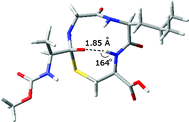Alternating chemical ligation reactivity of S-acyl peptides explained with theory and computations
Abstract
Previously discovered alternating reactivity of S-acyl di-, tri-, and

* Corresponding authors
a
Department of Chemistry, University of Florida, Gainesville, USA
E-mail:
katritzky@chem.ufl.edu
Fax: +1(352)392-9199
Tel: +1(352)392-0554
Previously discovered alternating reactivity of S-acyl di-, tri-, and

 Please wait while we load your content...
Something went wrong. Try again?
Please wait while we load your content...
Something went wrong. Try again?
A. A. Oliferenko and A. R. Katritzky, Org. Biomol. Chem., 2011, 9, 4756 DOI: 10.1039/C1OB05536D
To request permission to reproduce material from this article, please go to the Copyright Clearance Center request page.
If you are an author contributing to an RSC publication, you do not need to request permission provided correct acknowledgement is given.
If you are the author of this article, you do not need to request permission to reproduce figures and diagrams provided correct acknowledgement is given. If you want to reproduce the whole article in a third-party publication (excluding your thesis/dissertation for which permission is not required) please go to the Copyright Clearance Center request page.
Read more about how to correctly acknowledge RSC content.
 Fetching data from CrossRef.
Fetching data from CrossRef.
This may take some time to load.
Loading related content
